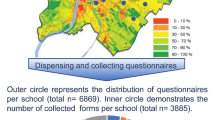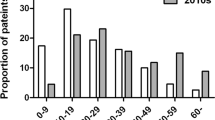Abstract
Purpose
The proportion of elderly people aged ≥ 65 years is increasing worldwide. Although the reported prevalence of sinonasal disease can vary according to the diagnostic methods used, differences in allergic rhinitis prevalence in the elderly according to diagnostic method have not been reported. We thus aimed to evaluate allergic rhinitis prevalence in the elderly according to diagnostic criteria obtained from questionnaires, physician diagnoses, and allergy tests.
Methods
We compared the allergic rhinitis prevalence in the elderly aged ≥ 65 years with adults aged 19–64 years, using data from the Korean National Health and Nutrition Examination Survey 2008–2012. Total serum IgE and IgE levels specific to allergens of Dermatophagoides farina, cockroach, and dog dander were examined, and factors affecting specific IgE levels were investigated.
Results
Allergic rhinitis prevalence according to the questionnaire responses, physician diagnoses, and allergy test results was 35.02%, 14.89%, and 17.56%, respectively. The prevalence based on all diagnostic methods assessed was significantly lower in the elderly than in the general adult group (p < 0.001). Rhinorrhea incidence was significantly increased in the elderly (p = 0.018). Sensitization to Dermatophagoides farina was significantly decreased in the elderly (p = 0.006) and did not correlate with socioeconomic status and/or general health factors.
Conclusions
The elderly population has a distinct clinical presentation, including a low prevalence of allergic rhinitis, and an increased incidence of rhinorrhea symptoms, compared with the general adult population. The management of allergic rhinitis in elderly patients may therefore require a different therapeutic approach to improve rhinorrhea rather than nasal obstruction.

Similar content being viewed by others
References
Chan A, Saito Y, Robine JM (2016) International perspectives on summary measures of population health in an aging world. J Aging Health 28:1119–1123
Bousquet J, Khaltaev N, Cruz AA et al (2008) Allergic Rhinitis and its Impact on Asthma (ARIA) 2008 update (in collaboration with the World Health Organization, GA(2)LEN and AllerGen). Allergy 63(Suppl 86):8–160
Busse PJ, Mathur SK (2010) Age-related changes in immune function: effect on airway inflammation. J Allergy Clin Immunol 126:690–699 (quiz 700-691)
Wuthrich B, Schmid-Grendelmeier P, Schindler C et al (2013) Prevalence of atopy and respiratory allergic diseases in the elderly SAPALDIA population. Int Arch Allergy Immunol 162:143–148
Kim JH, Cho C, Lee EJ, Suh YS, Choi BI, Kim KS (2016) Prevalence and risk factors of chronic rhinosinusitis in South Korea according to diagnostic criteria. Rhinology 54:329–335
Consultation WHOE (2004) Appropriate body-mass index for Asian populations and its implications for policy and intervention strategies. Lancet 363:157–163
Park YB, Mo EK, Lee JY et al (2013) Association between pet ownership and the sensitization to pet allergens in adults with various allergic diseases. Allergy Asthma Immunol Res 5:295–300
Cazzoletti L, Ferrari M, Olivieri M et al (2015) The gender, age and risk factor distribution differs in self-reported allergic and non-allergic rhinitis: a cross-sectional population-based study. Allergy Asthma Clin Immunol 11:36
Hanneuse Y, Delespesse G, Hudson D, de Halleux F, Jacques JM (1978) Influence of ageing on IgE-mediated reactions in allergic patients. Clin Allergy 8:165–174
Busse PJ (2007) Allergic respiratory disease in the elderly. Am J Med 120:498–502
Hwang CS, Lee HS, Kim SN, Kim JH, Park DJ, Kim KS (2019) Prevalence and risk factors of chronic rhinosinusitis in the elderly population of Korea. Am J Rhinol Allergy 33:240–246
De Martinis M, Franceschi C, Monti D, Ginaldi L (2006) Inflammation markers predicting frailty and mortality in the elderly. Exp Mol Pathol 80:219–227
Untersmayr E, Diesner SC, Bramswig KH et al (2008) Characterization of intrinsic and extrinsic risk factors for celery allergy in immunosenescence. Mech Ageing Dev 129:120–128
Droste JH, Kerhof M, de Monchy JG, Schouten JP (1996) Rijcken B (1996) Association of skin test reactivity, specific IgE, total IgE, and eosinophils with nasal symptoms in a community-based population study. The Dutch ECRHS Group. J Allergy Clin Immunol. 97:922–932
Bousquet J, Fokkens W, Burney P et al (2008) Important research questions in allergy and related diseases: nonallergic rhinitis: a GA2LEN paper. Allergy 63:842–853
Meltzer EO, Blaiss MS, Derebery MJ et al (2009) Burden of allergic rhinitis: results from the pediatric allergies in America survey. J Allergy Clin Immunol 124:S43–70
Jeong KY, Lee IY, Yong TS et al (2012) Sequence polymorphisms of Der f 1, Der p 1, Der f 2 and Der p 2 from Korean house dust mite isolates. Exp Appl Acarol 58:35–42
Lal A, Sunaina Waghray S, Nand Kishore NN (2011) Skin prick testing and immunotherapy in nasobronchial allergy: our experience. Indian J Otolaryngol Head Neck Surg 63:132–135
Pawankar R (2004) Allergic rhinitis and asthma: the link, the new ARIA classification and global approaches to treatment. Curr Opin Allergy Clin Immunol 4:1–4
Pinto JM, Jeswani S (2010) Rhinitis in the geriatric population. Allergy Asthma Clin Immunol 6(1):10
Lal D, Corey JP (2004) Vasomotor rhinitis update. Curr Opin Otolaryngol Head Neck Surg 12:243–247
Paula Couto TA, Falsarella N, Mattos Cde C, Mattos LC (2014) Total IgE plasma levels vary according to gender and age in Brazilian patients with allergic rhinitis. Clinics (Sao Paulo) 69:740–744
Park HJ, Kim EJ, Yoon D et al (2017) Prevalence of Self-reported Allergic Diseases and IgE Levels: A 2010 KNHANES Analysis. Allergy Asthma Immunol Res 9:329–339
Klink M, Cline MG, Halonen M, Burrows B (1990) Problems in defining normal limits for serum IgE. J Allergy Clin Immunol 85:440–444
Di Lorenzo G, Pacor ML, Esposito Pellitteri M et al (2003) A study of age-related IgE pathophysiological changes. Mech Ageing Dev 124:445–448
Ventura MT, Casciaro M, Gangemi S, Buquicchio R (2017) Immunosenescence in aging: between immune cells depletion and cytokines up-regulation. Clin Mol Allergy 15:21
De Amici M, Ciprandi G (2013) The age impact on serum total and allergen-specific IgE. Allergy Asthma Immunol Res 5:170–174
Stemeseder T, Klinglmayr E, Moser S et al (2017) Influence of intrinsic and lifestyle factors on the development of IgE sensitization. Int Arch Allergy Immunol 173:99–104
Acknowledgements
The authors thank the Biostatistics Collaboration Unit at Yonsei University for their help with the statistical analyses.
Funding
This research received no specific grant from any funding agency in the public, commercial, or not-for-profit sectors.
Author information
Authors and Affiliations
Contributions
J-SN, C-SH and K-SK designed the study. J-SN and K-SK wrote the manuscript. M-PH contributed to data collection. J-SN and C-SH performed the statistical analysis and K-SK interpreted the results. All authors read and approved the final manuscript.
Corresponding author
Ethics declarations
Conflict of interest
The authors declare that they have no conflict of interest and did not receive any financial support for the research, authorship, and/or publication of this article.
Ethics approval and Consent to participate
This study was approved by the institutional review board (IRB) of the Korea Centers for Disease Control and Prevention (IRB approval numbers: 2008- 04EXP-01-C, 2009-01CON-03-2C, 2010-02CON-21-C, 2011-02CON-06-C, and 2012-01EXP-01-2C).
Consent for publication
This study is has not been previously published whole or in part, and is not under consideration for publication elsewhere. Written informed consent was obtained from all participants before enrollment. All authors have read the manuscript, agree the work is ready for submission to a journal, and accept responsibility for the manuscript's contents.
Availability of data and material
The Korea National Health and Nutrition Examination Survey (KNHANES) continuous data used in the study is available publicly at Korea Centers for Disease Control and Prevention (KCDC) website at: https://knhanes.cdc.go.kr
Additional information
Publisher's Note
Springer Nature remains neutral with regard to jurisdictional claims in published maps and institutional affiliations.
Rights and permissions
About this article
Cite this article
Nam, JS., Hwang, CS., Hong, MP. et al. Prevalence and clinical characteristics of allergic rhinitis in the elderly Korean population. Eur Arch Otorhinolaryngol 277, 3367–3373 (2020). https://doi.org/10.1007/s00405-020-06256-5
Received:
Accepted:
Published:
Issue Date:
DOI: https://doi.org/10.1007/s00405-020-06256-5




